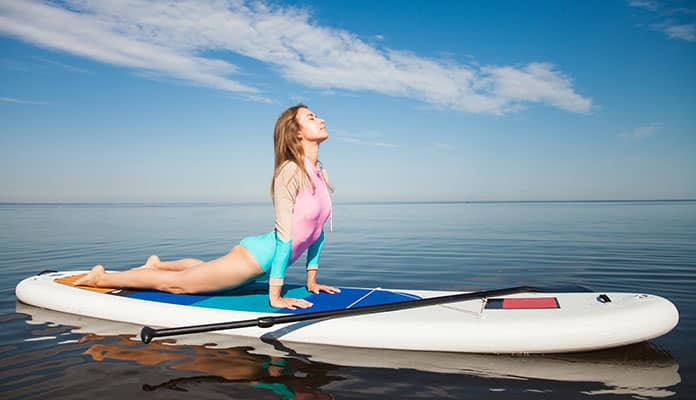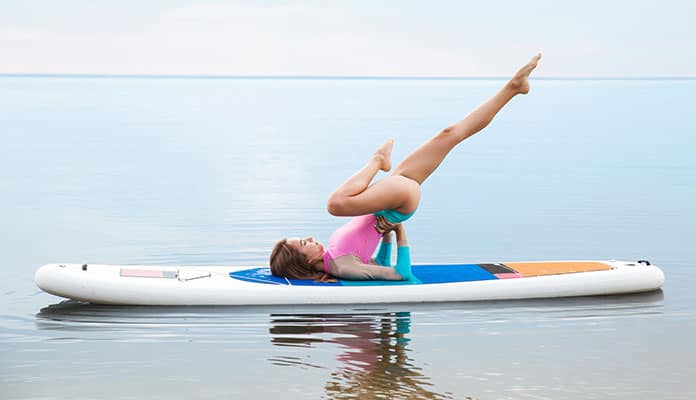
Yoga on paddleboards has become incredibly popular. Instead of practicing inside a building, or at home, yogis are taking their practice one step further and getting outside. The serenity felt on water being submerged in nature can have amazing effects on your mind, body, and spirit. You will be amazed at how fulfilling this activity can be.
We have put together some frequently asked questions and concerns about paddleboard yoga to help get you in the know and on the board.
5 Things to Know When Trying Paddleboard Yoga
1. Is SUP Yoga Hard?
The simple answer to this question is yes, it is more different than your average yoga class. But not difficult how you may think. It will take longer to get into poses and move between poses. This is because you will have to calculate the appropriate foot and weight disbursement. You will know if one of your legs is holding more weight than the other or if your hips are not in alignment.
You might also like: Best Yoga Paddle Boards
This will come naturally to you after a while but will require you to move a bit more thoughtfully through your practice. It will also help to make your routine more fluid as there is no place for harsh erratic movements. Put simply, SUP yoga will help to correct your routine and in the end, make you stronger and more confident.
Being on the board helps to remind you of the importance of balance. Stability is not about perfection, but it is something you will have to constantly be checking in on yourself. The constant movement of the water will help to remind you to stay focus and help you be more in tune with your practice.
Not just about balance, your muscles will feel it too. The constant balance and correction of SUP yoga will encourage you to engage your core muscles and give you a much deeper workout. Also, the constantly changing scenery will give your mind a workout as you are faced with much more distraction than when in a yoga room. All in all, SUP yoga will drastically improve your yoga practice while giving you a great workout.
2. What To Do If You Fall In
This is the biggest fear people face with the idea of SUP yoga. Understanding that the worst-case scenario is a simple you get wet helps to ease your thoughts. You must be comfortable in the water and know how to swim. On the chance that you do fall in, simply hop back on your board and try again.
Paddleboards are thick. They are meant to be stood on with some movement. Simply put, they are much more stable than you may think. Start with the flat waters of a small lake on a calm day. Eventually, you can go out despite some wind but generally speaking, paddleboarding is best done in calm waters.
3. What To Expect
You should expect to use different muscles than you are used to. Not only do you have to do the poses but you will be engaging different muscles to stabilize and balance in the water. This is why yoga on a paddleboard is so popular. You don’t use nearly as many muscles as you would on dry land.
Also, you should plan to get wet. This is especially true the first few times you practice on the water. You will quickly learn which type of boards are best for yoga and balance and which ones are more difficult. Don’t be afraid of the water. If you are nervous about getting wet try wearing a bathing suit as you are more mentally prepared than if you are wearing clothing. If you are still nervous, try walking your board out to waist-deep water to get the feel of it.
Remember: Yoga is about understanding your practice. You have judgment-free control over what poses to enter and how far to take your practice.
4. What To Wear

Alright, so you’ve decided to brave the water and try your hand at some SUP yoga. Now the real question: what should I wear? Dressing for paddleboard yoga isn’t all that different from dressing for your normal yoga class. Keep in mind that there is a chance you will get wet, if not from falling in from any splashes. Be sure that you wear clothing that you don’t mind getting wet. It is also best to wear clothing that is more form-fitted. Wearing bulky or loose-fitting clothes will be heavy if you fall into the water.
When practicing SUP yoga, it is best to do so barefoot. As you are practicing in direct sunlight there are a few extra things to think about. Be sure to always remember to apply sunscreen before your paddle. In warmer climates, you may want to pack extra along with you. You will also want to bring along a small towel to put on your eyes to help block out the sun. A pair of cheap sunglasses will also help with this.
5. What Are People Saying About SUP Yoga?
Reviews on paddleboard yoga are overwhelmingly positive. Most yogis agree that the serenity experienced when taking your practice to the lake is a unique and beautiful thing. With paddleboard yoga, it is often your fear that holds you back from doing it much more so than actual physical restriction. To combat the fear it is best to first try SUP yoga on a really warm day wearing clothes that you don’t mind getting wet. We often picture falling in as the worst-case scenario. The reality is, the worst thing that will happen is you get a bit wet. If you can take away the fear of getting wet by getting comfortable on hot days where you don’t mind if you go in, lots of fear will go away.
Globo Surf Overview
Yoga is about balance, yin, and yang. What better way to practice balance and overcoming your fears and self-made obstacles than taking your practice on a SUP. The spirit of yoga helps us to let go of our judgments and push through the limits. Practicing on a SUP requires much more mental strength than physical strength. Instead of jumping into dancers’ poses, start in a child’s pose and make your practice within your skill level. This is a great expansion of your practice that all skill levels can indulge in.
Yoga Paddle Board Guides:
Single Products Paddle Board Reviews:

